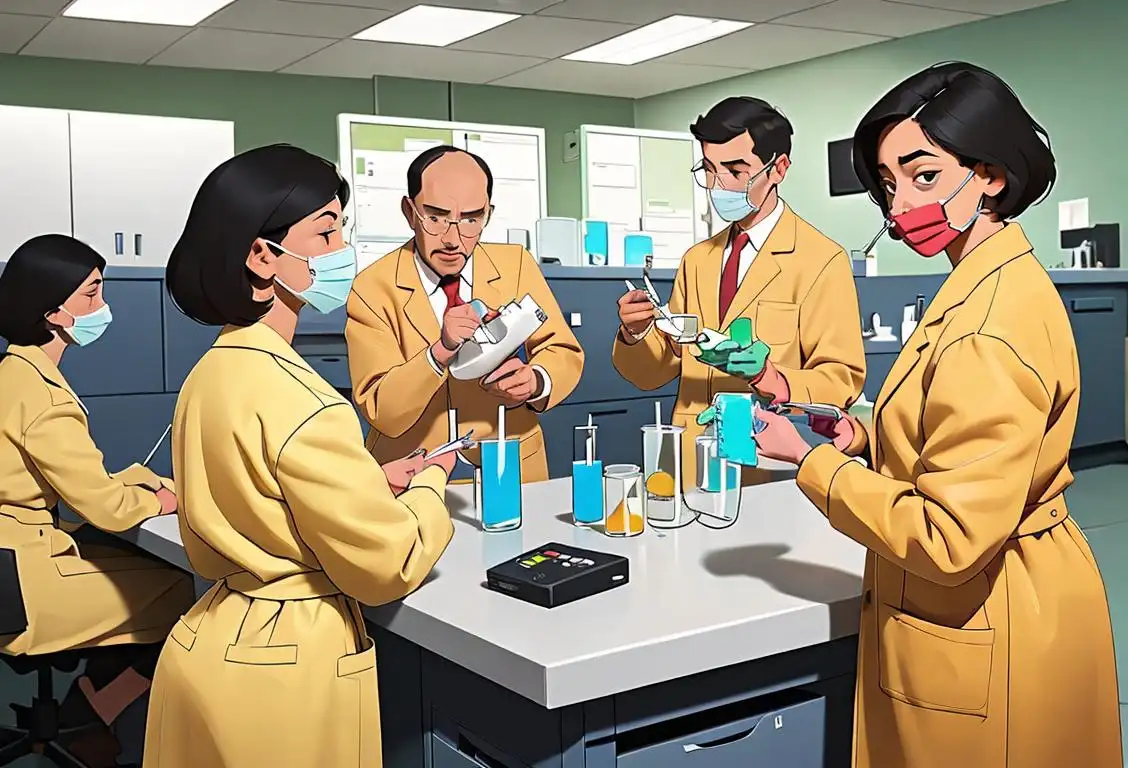National Haemochromatosis Awareness Day

Welcome, my friends, to the wacky world of National Haemochromatosis Awareness Day! Prepare to be educated, entertained, and maybe just a little bit confused as we dive into the internet history of this unique day.
When is Haemochromatosis Awareness Day?
It's national haemochromatosis awareness day on the 6th June.
The Internet Chronicles of National Haemochromatosis Awareness Day
Ah, National Haemochromatosis Awareness Day. It's a day dedicated to raising awareness about a condition that causes excess iron to build up in the body. Now, you might be thinking, 'Iron? Isn't that what they use to make swords and stuff?' Well, yes, you're right! But in this case, we're talking about iron overload in our bodies, not medieval weaponry.Now, let's hop in our time machine and travel back to the glorious year of 2019. On June 6th, the internet was buzzing with excitement about National Haemochromatosis Awareness Day. Twitter was all abuzz with tweets like, 'Iron overload? I thought that only happened in my laundry!' and 'I guess I need to start watching my iron intake... and not just when I'm pumping iron at the gym!'
But why all the fuss about haemochromatosis awareness? Well, my friends, it's because this condition can lead to serious health problems if left untreated. From fatigue to joint pain, and even more severe issues like organ damage, haemochromatosis can really pack a punch when it comes to your health. So, it's important to spread the word and encourage early detection and treatment.
A Fun Fact for Your Awareness Arsenal
Did you know that haemochromatosis is often referred to as the 'Celtic Curse'? Now, before you start picturing red-haired leprechauns dancing around pots of gold, let me explain. This nickname comes from the fact that haemochromatosis is most commonly found in individuals of Celtic descent. So, if you've got Irish, Scottish, or Welsh roots, you might want to keep an eye out for this sneaky condition.History behind the term 'Haemochromatosis Awareness'
1935
Discovery of Haemochromatosis
Haemochromatosis, a hereditary condition where the body absorbs too much iron from the diet, was first described by Dr. Armand Trousseau in 1865. However, it was not until 1935 that Dr. Sheldon Minot and Dr. William B. Castle discovered the link between iron overload and the disease. They found that individuals with haemochromatosis had an abnormal ability to accumulate and store excess iron in their organs.
1996
Discovery of the HFE gene
In 1996, researchers discovered a gene called HFE that is closely associated with a hereditary condition known as haemochromatosis. Haemochromatosis is a disorder characterized by excessive absorption of iron from food, leading to iron overload in various organs of the body. The discovery of the HFE gene marked a crucial milestone in understanding the genetic basis of haemochromatosis.
1975
Identification of HFE Gene
In 1975, researchers made a significant breakthrough in understanding the genetic basis of haemochromatosis. Dr. Pierre Brissot and his team identified a gene, later named the HFE gene, that was associated with the disease. This discovery paved the way for further research into the genetic factors contributing to haemochromatosis.
2000
Identification of common mutations
Four years later, in 2000, scientists identified two common mutations of the HFE gene, namely C282Y and H63D, which are strongly associated with haemochromatosis. These mutations disrupt the normal regulation of iron absorption, causing the body to accumulate excessive iron. This breakthrough in genetic research enabled better diagnosis and screening for individuals at risk of haemochromatosis.
2011
Recognition of World Haemochromatosis Week
In 2011, the World Haemochromatosis Week was recognized internationally, bringing attention to the condition and promoting awareness about haemochromatosis. This week-long event aims to educate the public, healthcare professionals, and policymakers about the signs, symptoms, and management of haemochromatosis. It also supports efforts to improve early detection and treatment options for affected individuals.
1996
Linking HFE Gene Mutation to Haemochromatosis
In 1996, scientists made another pivotal advancement in the understanding of haemochromatosis. They discovered that a specific mutation in the HFE gene, known as the C282Y mutation, played a central role in the development of the disease. This finding allowed for improved testing methods to identify individuals at risk of haemochromatosis and raised awareness about the importance of early detection and treatment.
2005
Establishment of Haemochromatosis Awareness Day
In 2005, the first Haemochromatosis Awareness Day was established to raise public awareness about the condition. This day, observed annually on August 22nd, aims to promote understanding of haemochromatosis, its symptoms, and the importance of early diagnosis and treatment. Various organizations around the world organize events, educational campaigns, and screenings to spread awareness and support individuals living with haemochromatosis.
2014
Establishment of Haemochromatosis Awareness Day
In 2014, Haemochromatosis Awareness Day was established to further raise awareness about this genetic disorder. This annual observance, held on August 22nd, provides an opportunity for various organizations and communities to unite in spreading information about haemochromatosis. It serves as a reminder to individuals to get tested for the condition and seek appropriate medical care if needed.
2020
Continued advocacy and research
In recent years, the awareness and understanding of haemochromatosis have continued to grow. Advocacy groups, medical professionals, and researchers work together to support individuals with haemochromatosis, improve diagnostic methods, and explore potential treatments. The ongoing efforts of these dedicated individuals contribute to increasing awareness and improving the lives of those affected by haemochromatosis.
Did you know?
Did you know that haemochromatosis is often referred to as the 'Celtic Curse'? Now, before you start picturing red-haired leprechauns dancing around pots of gold, let me explain. This nickname comes from the fact that haemochromatosis is most commonly found in individuals of Celtic descent. So, if you've got Irish, Scottish, or Welsh roots, you might want to keep an eye out for this sneaky condition.Tagged
awareness fun healthFirst identified
1st June 2017Most mentioned on
6th June 2019Total mentions
9Other days
Spinach Day
School Nurse Day
Lash Day
Frozen Yogurt Day
Fitness Day
Drug Test Day
Kale Day
Women Physicians Day
No Bra Day
No Smoking Day









